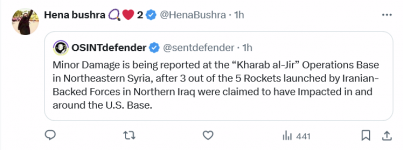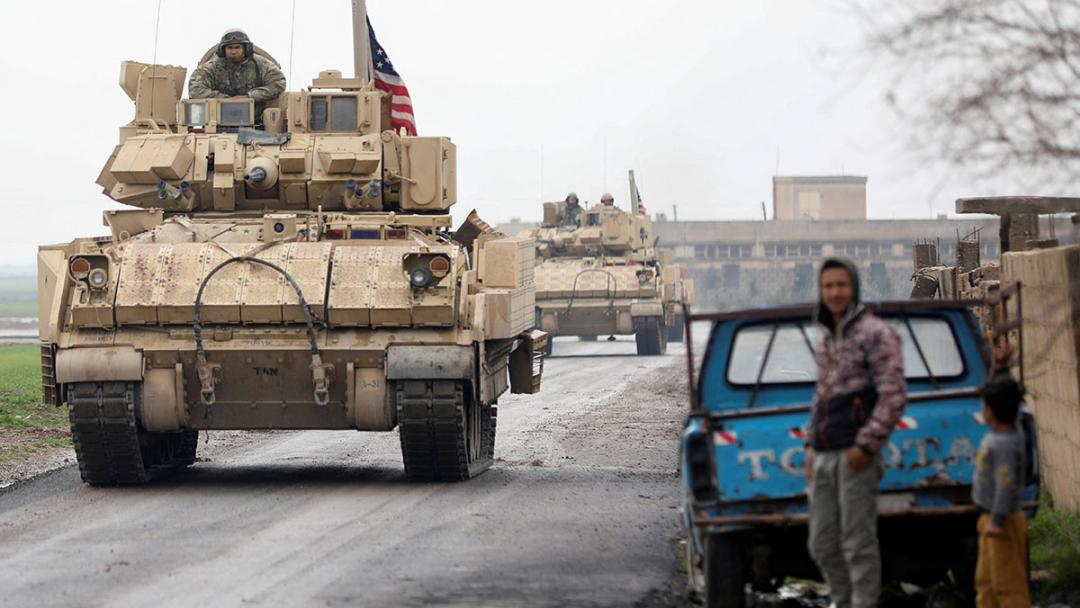How Iran Seeks to Exploit the Gaza War in Syria’s Volatile East | Crisis Group
Residents stand on a street during a joint U.S.- Kurdish-led Syrian Democratic Forces (SDF) patrol in the countryside of Qamishli, in northeastern Syria February 8, 2024. REUTERS / Orhan Qereman
Armed groups aligned with Tehran have launched attacks aimed at compelling the U.S. to withdraw troops from Syria – and from Iraq. A ceasefire in Gaza is the best way to calm tensions, but Washington and its local partner can take ameliorative steps in the meantime.
In the shadow of the Gaza conflict, armed groups aligned with Iran have stepped up a campaign aimed at pushing the U.S. to end its military deployments in Iraq and Syria. After mounting a series of direct attacks on U.S. bases in south-eastern Syria, which prompted a wave of retaliatory strikes, Iran shifted its focus to loosening the already shaky hold of the Kurdish-led Syrian Democratic Forces (SDF), which are allied with Washington, on lands east of the Euphrates River. Portraying the SDF as an occupying army aligned with a foreign power in a region predominantly inhabited by Arab tribes, Iran has been able to rally local groups to perpetrate attacks on this U.S.-backed force. While both Iran and the U.S. seem keen to avoid a wider escalation of regional conflict, the situation in eastern Syria is likely to remain volatile, at least until Israel and Hamas reach a ceasefire in Gaza. Pressing for an end to that conflict and, in the meantime, pushing the SDF to build bridges with alienated Syrian communities are ways for Washington to help defuse tensions in the region.
An Escalatory Spiral Halted
On 18 October 2023, a day after hundreds of people were killed at the al-Ahli Arab hospital in Gaza in an explosion that
Arab media overwhelmingly blamed on Israel but for which Israel denied responsibility, drones and missiles were launched at U.S. military bases at al-Tanf and the Conoco gas field, both in eastern Syria. The Islamic Resistance in Iraq, an alliance of Iran-aligned formations that includes Kataib Hizbollah, Harakat al-Nujaba and Kataib Sayyid al-Shuhada, claimed
responsibility for the attacks, which they labelled “revenge for Gaza”.
Part of the Hashd al-Shaabi (Popular Mobilisation), an amalgam of Iraqi militias that assembled in 2014 to fight the Islamic State, or ISIS, and were integrated into the Iraqi security apparatus in 2016, these armed groups now also operate in Syria. Working outside the Iraqi state structure with the support of Iran’s Islamic Revolutionary Guards Corps, they are stationed in government-controlled areas west of the Euphrates alongside other Iran-aligned groups. For nearly a year until the 18 October barrage these groups had not struck U.S. troops, instead observing a unilateral ceasefire they had declared in support of the newly formed Iraqi government of Prime Minister Mohammed Shiaa Sudani. The October strikes were also the first shots of some 150 they would take at U.S. assets in Syria and Iraq by the end of January 2024.
The U.S. bases’ air defence systems fended off nearly all the attacks, which caused injuries but no fatalities among U.S. forces.
Retaliation was slow in coming, but in November and
December the U.S. started hitting the armed groups in question in Iraqi cities and near government facilities.
Strikes on Iranian-backed groups in eastern Syria and the killing of a senior Revolutionary Guards commander in Damascus in late December, both unclaimed but attributed to Israel, turned up the
heat.
Worse was to come for U.S. forces in the area. A drone attack on 28 January 2024 on Tower 22, a U.S. base in Jordan near Rukban that provides support for U.S. military operations across the border in Syria, killed three U.S. soldiers and injured 40. Responsibility for the attack was claimed by the Islamic Resistance in Iraq. U.S. officials stated that the base’s air defence system mistook the incoming drone for a U.S. device returning from a mission and therefore failed to intercept it. Since it was the first attack ever by Iran-backed groups on U.S. forces in Jordan, which has long been free of the violence characterising the Syrian and Iraqi theatres of conflict, the strike in itself marked a clear provocation. Sources in the group claim that it did not anticipate killing U.S. soldiers at Tower 22, expecting that the base’s air defences would take down the drone, as had happened many times before. But by claiming U.S. lives, even if that was not the expected outcome, the attack crossed a threshold that made a forceful U.S. response all but a foregone conclusion.
The Iran-affiliated armed groups were clearly aware they had overstepped their bounds. They promptly evacuated bases in eastern Syria and western Iraq. Esmail Qaani, commander of the Revolutionary Guards’ elite Qods force, reportedly
arrived in Baghdad
within hours to tell the Iraqi groups to de-escalate, apparently concerned that the U.S. might retaliate against Iran directly. On 30 January, Kataib Hizbollah
issued a statement announcing it would suspend attacks on U.S. troops. Other groups, such as Harakat al-Nujaba, vowed to continue their campaign but nevertheless scaled down their attacks significantly.
In an initial response on 3 February, the U.S. attacked 85 locations in Syria and Iraq. Revolutionary Guards commanders and affiliated militia members had had nearly a week to evacuate, so many of the ammunition and weapons warehouses the U.S. hit were reportedly empty, but the combined death toll still reached 51. The 34 fatalities in Syria included members of Syrian, Lebanese, Iraqi, Afghan and Pakistani groups linked to Iran. The strikes in Iraq killed sixteen Hashd members unaffiliated with the Iran-backed groups, as well as a civilian. In a second response on 7 February, a U.S. drone strike in Baghdad killed senior Kataib Hizbollah commander Abu Baqir al-Saadi. In the aftermath of these retaliatory strikes, the Iraqi armed groups continued to harass U.S. positions in Syria, albeit with lesser frequency and training their sights more on bases near the gas and oil fields in the east. On 25 February, Harakat al-Nujaba
announced a temporary suspension of hostilities against U.S. forces, vowing to
continue attacks on the U.S. “until the end of the Gaza war”. After a 30-day halt, Iraqi groups resumed only sporadic attacks on U.S. bases in eastern Syria.
A Shift in Focus
The Tower 22 attack marked an inflection point, with Iran and its Iraqi allies seemingly opting to dial back the intensity and scope of direct attacks on U.S. troops in its aftermath to avoid a wider escalation that could jeopardise their long-term interests. That said, the influx of weapons and fighters into eastern Syria has continued. Since the end of January, the Iran-backed groups have shifted their focus: rather than solely attacking the U.S. military, they have rallied Arab tribal militias against the SDF as a way to weaken the latter’s hold on local power while bolstering their own position in eastern Syria. This strategy has involved a growing division of labour. Those Iran-backed groups composed of fighters from outside Syria have targeted U.S. bases, while Arab tribal militias based in government-held areas and backed by the Revolutionary Guards and the Syrian government have stepped up attacks on the SDF. During February and March, these tribal militias fired rocket-propelled grenades at SDF positions along the Euphrates and attempted incursions into territory held by the group on a near-daily basis.
Targeting the SDF has a clear strategic logic: keeping the conflict local, thus posing limited risk of U.S. retaliation. (After a drone attack by Iraqi groups near the U.S. base at the Omar oil field on 5 February killed seven SDF members, the U.S. refrained from escalating.) The Arab militias oppose the Kurdish-dominated SDF’s rule over large parts of eastern Syria and have branches extending deep into SDF-controlled territory, where their kin say they are suffering under Kurdish rule.
Mistrust of SDF governance is prevalent among Arab communities in these areas, which believe that the group gives Kurds preferential political and economic treatment. Arabs also resent the SDF’s compulsory recruitment practices, adding to the sources of discontent that have allowed the Syrian government and Iran to make inroads in these communities.
Targeting the SDF has a clear strategic logic: keeping the conflict local, thus posing limited risk of U.S. retaliation.
Iran-backed groups and the Syrian government brand the SDF an occupying army aligned with a foreign power in a bid to boost recruitment of fighters from among the tribal groups. U.S. support for Israel in the Gaza war has provided additional fodder for their enlistment campaign. Many Arabs in eastern Syria are wary of non-Arab Iran, which they suspect of having an intent to convert the locals, who are mostly Sunni Muslims, to Shiism. But for the time being, a shared sense of outrage over Gaza and Muslim solidarity has superseded these doubts.
Iran has focused its recruitment efforts on the vicinity of Khasham, a town east of Deir al-Zor, the only government-controlled area on the eastern bank of the Euphrates. By raising a loyal militia, Tehran seems to hope to secure a river crossing to facilitate lucrative smuggling and infiltration into SDF-held areas near the Conoco gas field and the U.S. base there. In November, Iran-backed groups opened recruitment offices in this area, offering monthly salaries of 1.5 million Syrian pounds ($107 at the black-market rate), twice the amount paid to Iran-backed militia fighters elsewhere in Syria, and closer to the two million pounds ($143) the SDF gives its recruits. Tribal fighters receive training at Revolutionary Guards bases in al-Bukamal and al-Mayadeen, and are equipped with light and medium weapons, including rocket-propelled grenade launchers and DShK machine guns.
Adding to the SDF’s predicament is the fact that a third regional power – Türkiye – is bent on destroying it, viewing the group as an arm of the Kurdistan Workers Party, or PKK, which Türkiye, the U.S., the EU and some other states consider a terrorist organisation. Türkiye has targeted critical infrastructure in SDF-held areas in northern and north-eastern Syria in three distinct waves of intense shelling in October, December and January in response to PKK attacks on the Turkish army in northern Iraq. Its heavy bombardment has disrupted water and electricity provision, and reduced oil and gas production, which is the main source of income for the SDF-dominated Autonomous Administration of North and East Syria. An all-out Turkish invasion aimed at defeating the SDF would likely trigger mass civilian displacement, especially of Syrian Kurds.


 israelradar.com
israelradar.com




